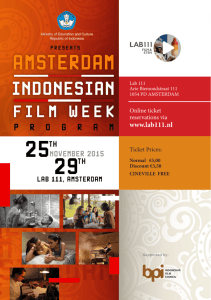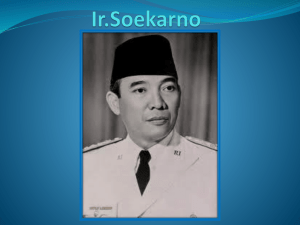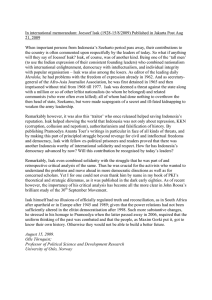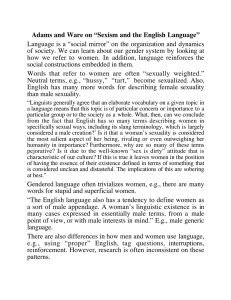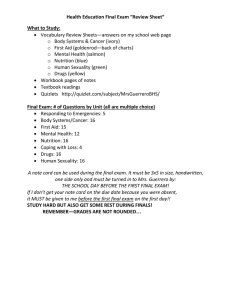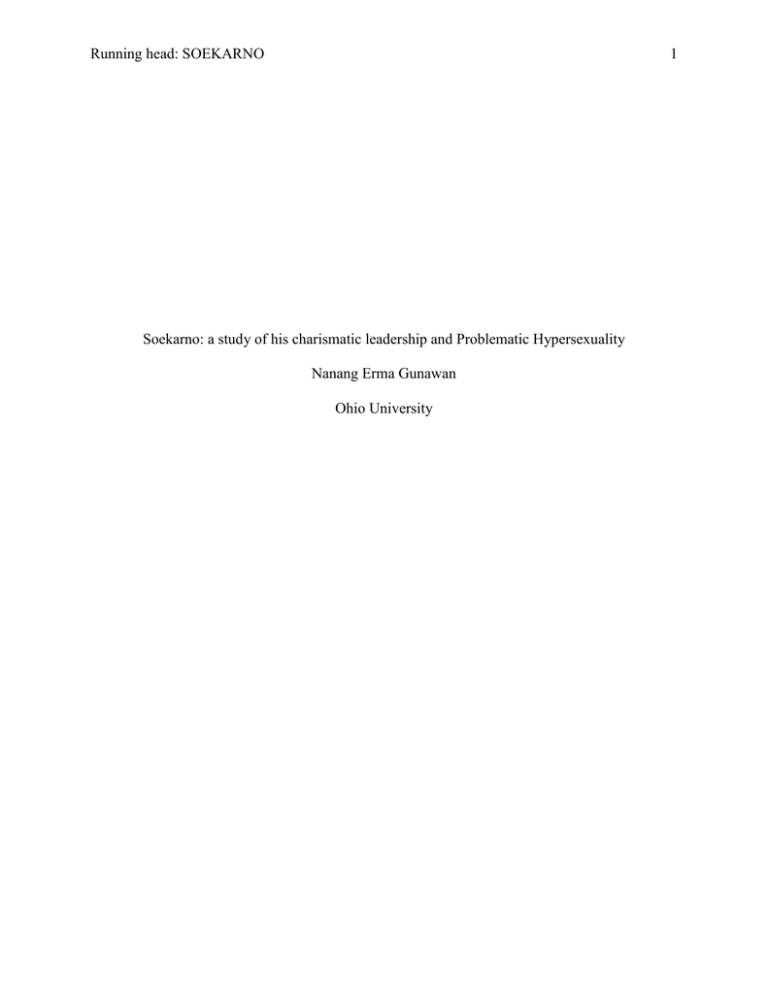
Running head: SOEKARNO
1
Soekarno: a study of his charismatic leadership and Problematic Hypersexuality
Nanang Erma Gunawan
Ohio University
SOEKARNO
2
Abstract
Soekarno was the first President of Republic of Indonesia post-independence day in
1945. He had charisma which enabled him to inspire Indonesian people to struggle against Dutch
who colonialized Indonesia for about 350 years. Through his inspiring and patriotic leadership,
Soekarno was not only known as an influential president but also he used his charisma to attract
and have sex with several women (Susilo, 2008). All this time, Soekarno’s sex life left questions
since it was religiously unaccepted and ethically was taboo to expose a president’s privacy.
Although his sexual behaviors indicate hyper sexuality disorder, many people love him as a big
president and a national pride. This article, accordingly, aims to discuss his sex behavior in terms
of clinical profile, etiology and possible treatment, a journal critique, and an overarching issue on
leadership role for community wellbeing.
Keywords: Soekarno, Hypersexual Disorder, Leadership, Community Wellbeing
SOEKARNO
3
Soekarno’s leadership, polygamy, and people’s amazement
Soekarno has succeeded to absolve Indonesia from Dutch colonialism. Together with
Mohammad Hatta, he declared the independence of Indonesia after Hiroshima and Nagasaki
atomic bomb in August 17, 1945 (Susilo, 2008). However, not all people liked Soekarno because
of his polygamy. Indonesian women activist organizations protested him, but it did not change
his position and mind to have more affairs with women. Apparently, other Indonesian group of
people did not consider significantly his affairs which contradict with Eastern culture particularly
Islam values. In fact, many Indonesians still admiring Soekarno (Tianlean, 2002).
The clinical profile of Soekarno
The young Soekarno started to admire girls since his 14 such as Rika Meelhusyen,
Pauline Gobee, and Laura, but he was not successful to attract those Dutch girls. During his life,
Soekarno had nine wives but some historians predicted that there were more (Nuryanti, et.al.,
2007). It is a kind of make sense because he could not suspend his sexual desire when seeing a
beautiful woman. Nuryanti, et.al., (2007), reported Soekarno’s adjutant statement“Yes, I am
excited to see beautiful women. I feel dong a sin if I pretend to say not or as if I don’t like them.
Doing such pretense is a lie and I don’t want to lie.” Moreover he said to his autobiography
author, Cindy Adams, “ I’m a very physical man. I must have sex every day.”
Soekarno’s first wife was Siti Utari. They divorced because Soekarno had an affair with
his landlady in Bandung, Inggit Garnasih. Inggit was divorced and Soekarno married to his
adopted daughter, Fatmawati. Soekarno had six more wives such as Hartini, Ratna Sari Dewi or
Naoko Nemoto, Haryati, Yurike Sanger, Kartini Manopo, and Heldy Djafar. Most of them
refused him to do polygamy but he kept looking for other women (Soyomukti, 2009).
According to Diagnostic Statistical Manual IV (DSM-IV) Soekarno’s behavior indivates
poor sexual urges control toward women and adverse consequences to him and others. These
SOEKARNO
4
symptoms indicate a problematic hyper sexuality (PH). In addition, he also exposed several traits
suggesting callousness, lack of remorse, impulsivity and ignorance to his wives feelings and
sociocultural norms.
Etiology and possible treatment
Soekarno’s sexual behavior can be analyzed through biological, psychological, social,
and sociocultural dimensions. Biologically, autonomic nervous system may have affected his
system reactivity and anxiety. His behavior shows that he was easy to adore women without
empathy to his wives. Psychologically, Soekarno was known as a brave person. His fearless and
persuasion influence people to obey him easily. Consequently, it was easy for people to be bent
down including women. I believe that his psychological dimension also related to his social
dimension which allows him to have strong desire on women. When he was living in
Tjokroaminoto’s house, he considered Tjokroaminoto’s wife as a perfect mother for her ways to
treat him. This was the reason why Soekarno married to her doughter, Siti Utari. Utari could not
be like her mother, so she was divorced. This case indicates that Soekarno lacked of mother
affection and then he look for more attachments with women. The sociocultural condition might
have huge impact to Soekarno’s behaviors. In the previous decades, Javanese kings had more
than one wife but basically it was not allowed by Islam (Fathurohman, 2007).
According to Inescu (2012), Cognitive Behavior Therapy works for individual with
problematic hyper sexuality like Soekarno. Through this approach, consequences of his behavior
can be reflected and help him to make a decision before hunting another girl to marry. In
addition, religious approach would be beneficial in order to make him aware about the principles
he believed in and the consequences of breaking it. I believe that I will need to research more
about Soekarno’s hypersexuality to formulate a more accurate treatment approach.
SOEKARNO
5
Critique a journal article
Having read a journal article titled Hypersexuality in college students: The role of
Psychopathy (Kastner & Sellbom, 2012) I tried to relate Soekarno’s hyper sexuality and his
heroic behaviors. This article has given me information about the symptoms of hyper sexuality in
relation to psychopathy which several of them are match with Soekarno’s case. Soekarno’s
callousness, lack of remorse, impulsivity, and inability to learn his wives feeling may indicate
psychopathic behavior in heroic context (Sue, Sue, & Sue, 2010). However, this journal was
written based on the research on western undergraduate college students so that the result will
probably distinct when the measurement is implied to eastern students or adults in terms of the
Fearless Dominance (FD) and Impulsive Antisociality (IA), especially in Indonesia.
Discussion on an over-arching issue
People tolerated Soekarno’s behaviors since he was a revolutionary figure. Although his
patriotism brought the independence of Indonesia but people need to be critical on a president’s
behavior. In Indonesia, a leader serves as a model for people in community, so they need to be
wiser in imitating a leader’s behavior. People can learn how to be patriotic and revolutionary like
Soekarno but they have to deliberate deeply in treating women to maintain the social order of
society.
Soekarno should have sufficient treatment during his chronic illness. He had fail kidney
because too much consuming sex drug and dead in 1970 in the custody after a coup d’état by the
next president, Soeharto. Ethically Soekarno should receive enough health care, but people did
not know much about his condition because of Soeharto’s conspiracy and the authoritarian
administration in that time. Today, people are missing a visionary, majestic, and revolutionary
president like Soekarno but not his problematic hyper sexuality disorder.
SOEKARNO
6
Reference
Erka. (1978). Bung Karno! Perginya seorang kekasih suamiku dan kebanggaanku. Semarang:
Aneka.
Fathurohman, I. (2007). Saya tidak ingin poligami tapi harus poligami: menelisik alasan kenapa
Aa Gym beristri dua. Hikmah.
Inescu, A. C. (2012, March). The treatment of hypersexuality using the cognitive behavioral
therapy and the virtual reality. In Proceedings of the 2012 Virtual Reality International
Conference (p. 10). ACM.
Kastner, R.M., Sellbom, M. (2012). Hypersexuality in college students: The role of psychopathy.
Personality and Individual Differences 53, 644-649.
Martin, L. (1992). Kisah cinta Inggit dan Bung Karno. Jakarta: PT Pijar Fendra Gemilang.
Nuryanti, R. et.al. (2007). Istri-istri Soekarno. Yogyakarta: Ombak.
Sue, D., Sue, D.W., & Sue, S. (2010). Understanding abnormal behavior (9th ed.). Boston, MA:
Wadsworth.
Susilo, T.A. (2008). Soekarno: Biografi Singkat 1901-1970. Yogyakarta: Garasi.
Soyomukti, N. (2009). Perempuan di mata Soekarno. Yogyakarta: Ombak.
Tianlean, B.A.G. (2002). Bung Karno antara mitos dan realita. Jakarta: Komite Penegak
Keadilan dan Kebenaran.

